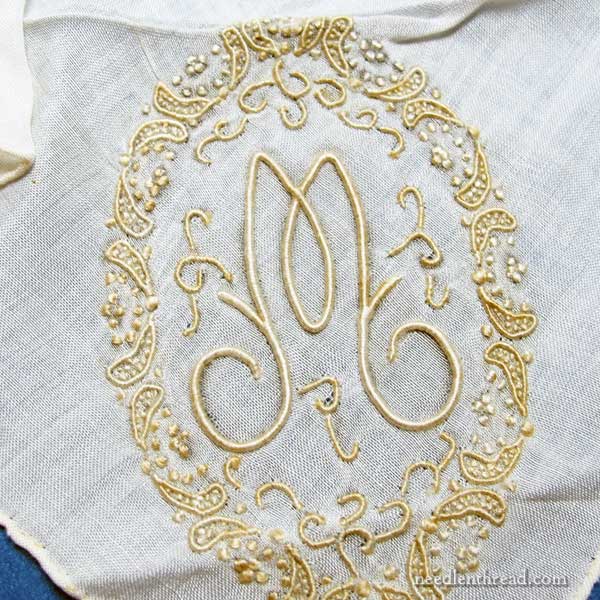A couple weeks ago, we looked at some vintage embroidered handkerchiefs and discussed how to tell the difference between hand embroidery and machine embroidery on vintage pieces.
Today, we’re going to look at another vintage handkerchief, embroidered in a style that can only be hand embroidery.
It’s a monogrammed hanky with (ahem…) an M. Needless to say, I don’t mind the M!
In fact, I’m kind of partial to the M.

Don’t be fooled by the gold-ish color of the embroidery. What you’re looking at is whitework embroidery, worked in white thread, but the threads are discolored from age.
Strangely enough, it’s only the thread that’s discolored – the fabric itself is still white and does not show the same degree of discoloration. Parts of the embroidery, too, are not discolored.
And even more strangely, the embroidery is unevenly discolored. In some places, the discoloration starts on one thread and continues in a small space, and then the thread returns to white. Looking at the back of the work, there is no evidence that there was any change of thread – so the discoloration is indiscriminately blotchy.
I haven’t attempted to clean this piece, but I think I will. I’ve hesitated, because I like the fact that the tag is still on it:

And I like the tag!
In the mid-1900’s, the Carol Stanley Studio of New York designed ladies’ accessories like scarves and handkerchiefs, some of which were hand embroidered, often in Switzerland. The line was sold at fine department stores like Lord & Taylor.
You can, incidentally, find old advertisements for Carol Stanley Studio’s hankies here and there in vintage publications.
The Carol Stanley hankies, depending on the type, ran anywhere from $1 – $2, which would be the equivalent, today, of about $10 – $20.
To get some perspective on spending a whole dollar in 1950, I talked to my mom and dad. That was the year my mom’s dad died, and that fall, at 16, she got her first job. She made about $4 a day, working 8 – 10 hour days. So, to spend $1 on a hanky – especially when you could buy one for 10 cents at the dime store – would have been considered Pretty Ritzy!

Even without the tag, though, we can tell that this monogram is definitely hand embroidered. The technique – which produces a very smooth, almost cord-like appearance on the surface of the fabric – is a form of satin stitching, specifically called trailing.
Trailing is satin stitching over a string or a group of strings.
It’s a gloriously gorgeous technique when done well. It’s often used for hand embroidered monograms and it shows up in whitework quite frequently.
If you’d like to see a good explanation of what trailing is and how it is done, you might check out Tracy Franklin’s series on her Crathorne Bug project, and specifically, this article about trailing.
I do love these lovely vintage handkerchiefs, which were a gift from Jane, a reader here on Needle ‘n Thread. There are so many treasures among them, and I love reading their stories!
I hope you enjoy them, too!
